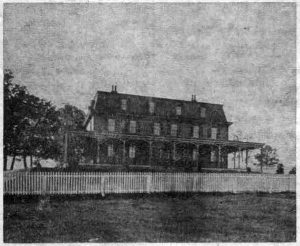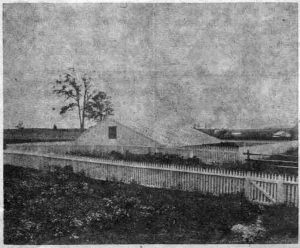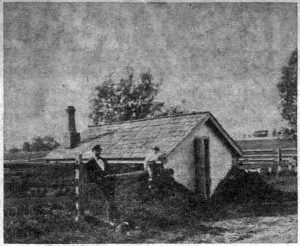As Mr. Askin stood on the large front porch of his beautiful home, “Louella House”, of which we showed pictures in this column last week, he could look up the hill to the south and see the wide-spreading acres of the Siter, the Fritz and the Mifflin farms.
The Mifflin farm faced on Conestoga road, with its main buildings located about where the Donald C. Mills family now lives on Upland Way. The farm had an entrance lane from Lancaster Pike which left the Pike at the site of the big tree where St. Mary’s Church now stands. Mrs. William H. Badger’s house on Windermere avenue was built directly on this old lane, which was lined on either side by some of the magnificent trees still on Mrs. Badger’s lawn.
 Our first picture in this week’s column shows a large double frame house which, in Mr. Askin’s time, stood about where Mrs. John H. Stone’s home is located at the southeast corner of Louella avenue and Upland Way. While the picture is included in the large book of handsome photographs of “Louella House”, given to the Radnor Historical Society by Heman P. Lengel, ownership of the house is not on record. It seems likely it was part of the Mifflin holdings.
Our first picture in this week’s column shows a large double frame house which, in Mr. Askin’s time, stood about where Mrs. John H. Stone’s home is located at the southeast corner of Louella avenue and Upland Way. While the picture is included in the large book of handsome photographs of “Louella House”, given to the Radnor Historical Society by Heman P. Lengel, ownership of the house is not on record. It seems likely it was part of the Mifflin holdings.
The interesting part of this house, with its mansard roof and its neat, white picket fence, is that some years after this picture was taken, it was lifted from its foundations and placed on rollers to be moved to the Bellevue Hotel, the fashionable summer hostelry which was located on the site of the Helen Kellogg dining room. Joined to the hotel, it was to serve as additional kitchen quarters.
Apparently all went well with this moving job, until the movers reached a point on South Wayne avenue, about where Mrs. Robert P. Elmer’s house now stands. It may have been caused by the momentum gained on the down grade on Windermere avenue just before it reached this point, but at any rate, the big farm house completely collapsed there. And the Bellevue Hotel did not have the additional kitchen space on which it had counted!
The site on Louella avenue made vacant by his moving, is approximately that of Mrs. Stone’s home. This house was originally occupied by the father of the late Mr. Louis Watt, who was president of the Wayne Title & Trust Company. John H. Stone bought this house from Mr. Watt.
 The second picture shows what was described as the “New Reservoir” in the early seventies, when these pictures were taken. This was located to the southwest of the grounds at the corner of Louella and Windermere avenues, on which the Windermere Court Apartments now stand. The “Table of Contents” in the book of photographs states that “this was erected on the hill, with sufficient elevation to furnish all the rooms in the Louella Mansion (even the highest) with a plentiful supply of water, as well as the barns and other buildings.”
The second picture shows what was described as the “New Reservoir” in the early seventies, when these pictures were taken. This was located to the southwest of the grounds at the corner of Louella and Windermere avenues, on which the Windermere Court Apartments now stand. The “Table of Contents” in the book of photographs states that “this was erected on the hill, with sufficient elevation to furnish all the rooms in the Louella Mansion (even the highest) with a plentiful supply of water, as well as the barns and other buildings.”
 The third picture shows the pump house located, according to the picture caption, “on Midland avenue, near the Willow trees”. This contained the wheel and the pump to force water into the Mansion house and its surrounding buildings. The man in the picture is identified as David H. Lane. Now, 80 years after it was taken, it would be interesting to identify also the small boy with his round brimmed hat, his tight, below-the-knees trousers, and his high buttoned shoes.
The third picture shows the pump house located, according to the picture caption, “on Midland avenue, near the Willow trees”. This contained the wheel and the pump to force water into the Mansion house and its surrounding buildings. The man in the picture is identified as David H. Lane. Now, 80 years after it was taken, it would be interesting to identify also the small boy with his round brimmed hat, his tight, below-the-knees trousers, and his high buttoned shoes.
In connection with the pictures of the reservoir and the pump house, Harry W. Slaw, of Pennsylvania avenue, tells your columnist that his father, the late Mr. Benjamin F. Slaw, of Newcastle, Del., was the first engineer of the Water Works System in Radnor Township.
The second pump house to be built after the one shown in the picture was also located on Midland avenue, near its western end. This was a good sized brick building, with a stack. It was through Isaac F. Cassin, who built this, that Mr. Slaw, a friend of his, obtained his position as engineer. A later reservoir was located on Bloomingdale avenue, about where Mr. Thomas C. Chalfont now lives. Later, the reservoir used until the Springfield Water Company came into operation, was built on Radnor road, opposite the Valley Forge Military Academy.
 The fourth picture Mr. Slaw did not recognize at first. Then on closer scrutiny he exclaimed, “Why, I could put my foot on that identical spot on Vance Hale’s backyard… I recognize it by the rock!” When the picture was taken, it was the famous drinking spring in the meadow just south of the Pike, opposite Louella Mansion. The big rock was known as “Frog Rock”. In the background of the picture is the big frame house on the hill shown in our first pictures, while to the right is a glimpse of the white, covered reservoir. The great expanse of ground that was then cornfields is now occupied by the Wayne Schools and by Windermere Court.
The fourth picture Mr. Slaw did not recognize at first. Then on closer scrutiny he exclaimed, “Why, I could put my foot on that identical spot on Vance Hale’s backyard… I recognize it by the rock!” When the picture was taken, it was the famous drinking spring in the meadow just south of the Pike, opposite Louella Mansion. The big rock was known as “Frog Rock”. In the background of the picture is the big frame house on the hill shown in our first pictures, while to the right is a glimpse of the white, covered reservoir. The great expanse of ground that was then cornfields is now occupied by the Wayne Schools and by Windermere Court.
(to be continued)
